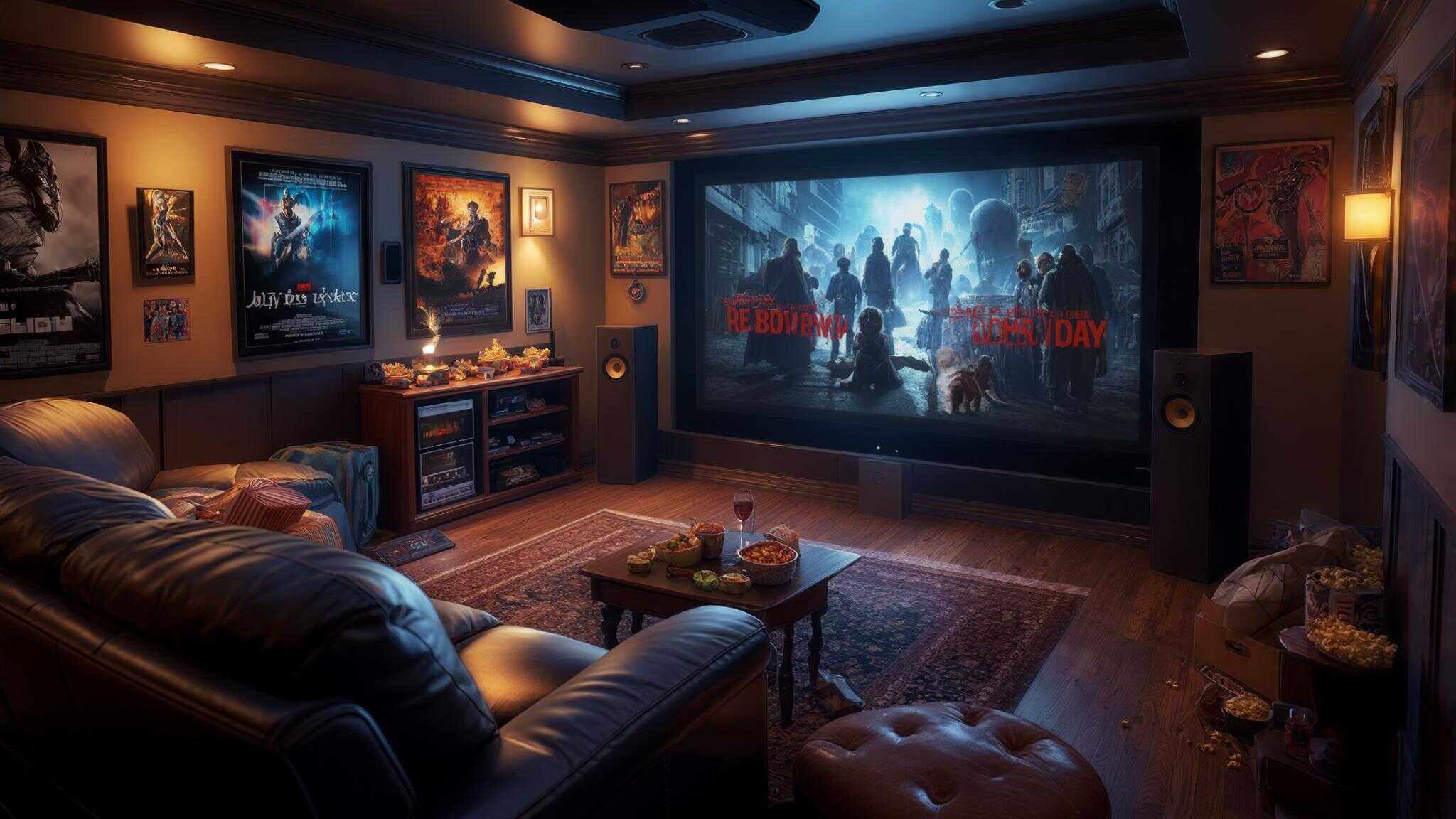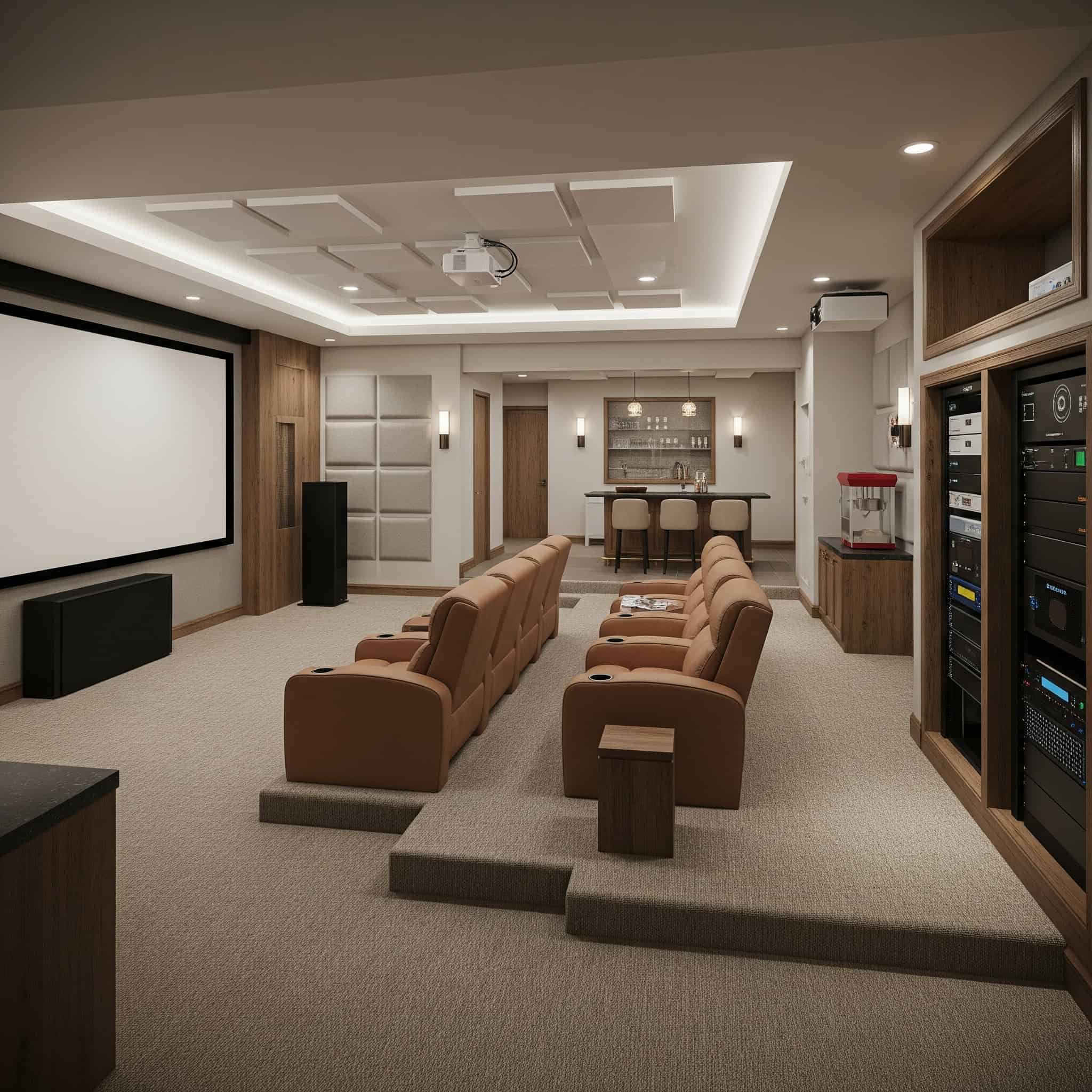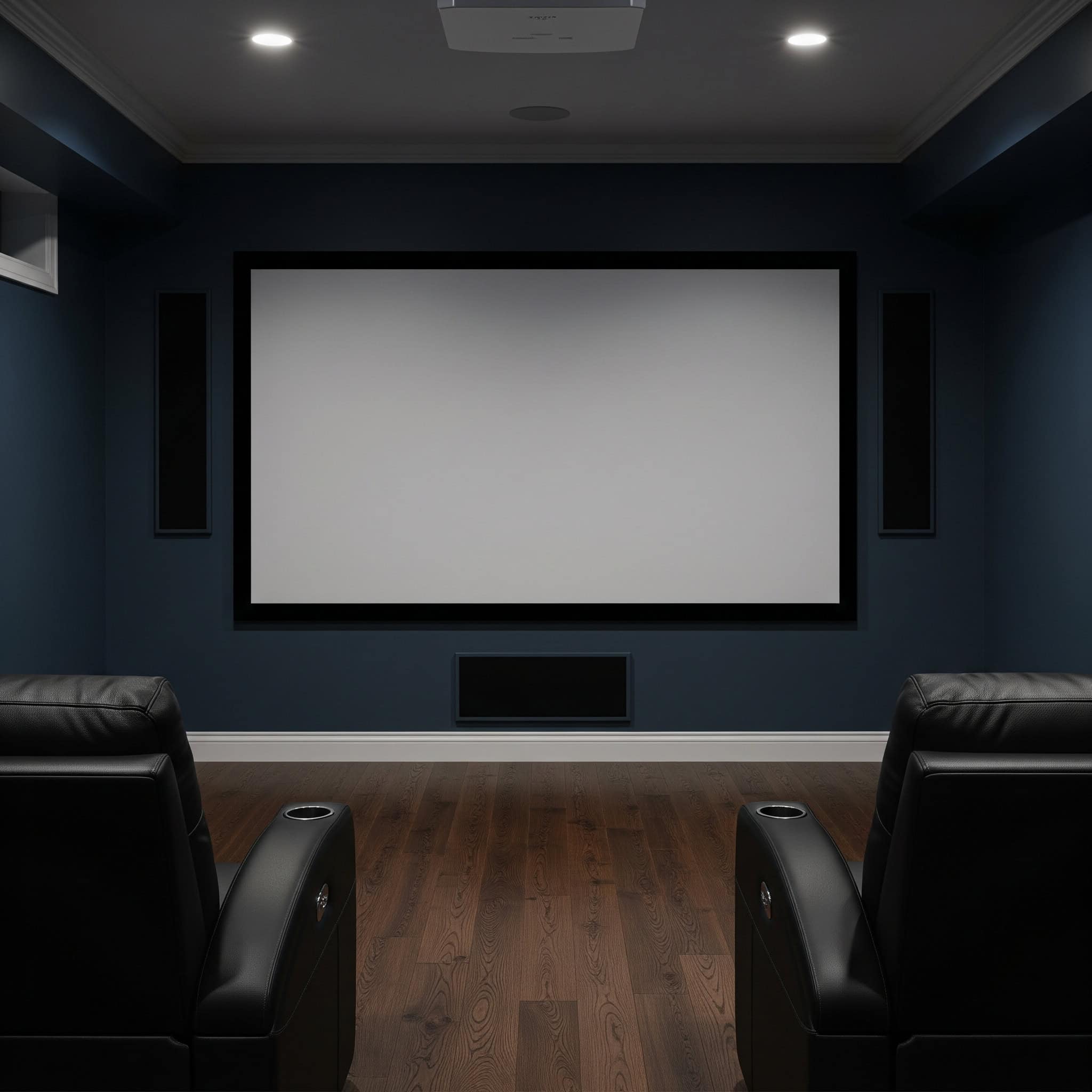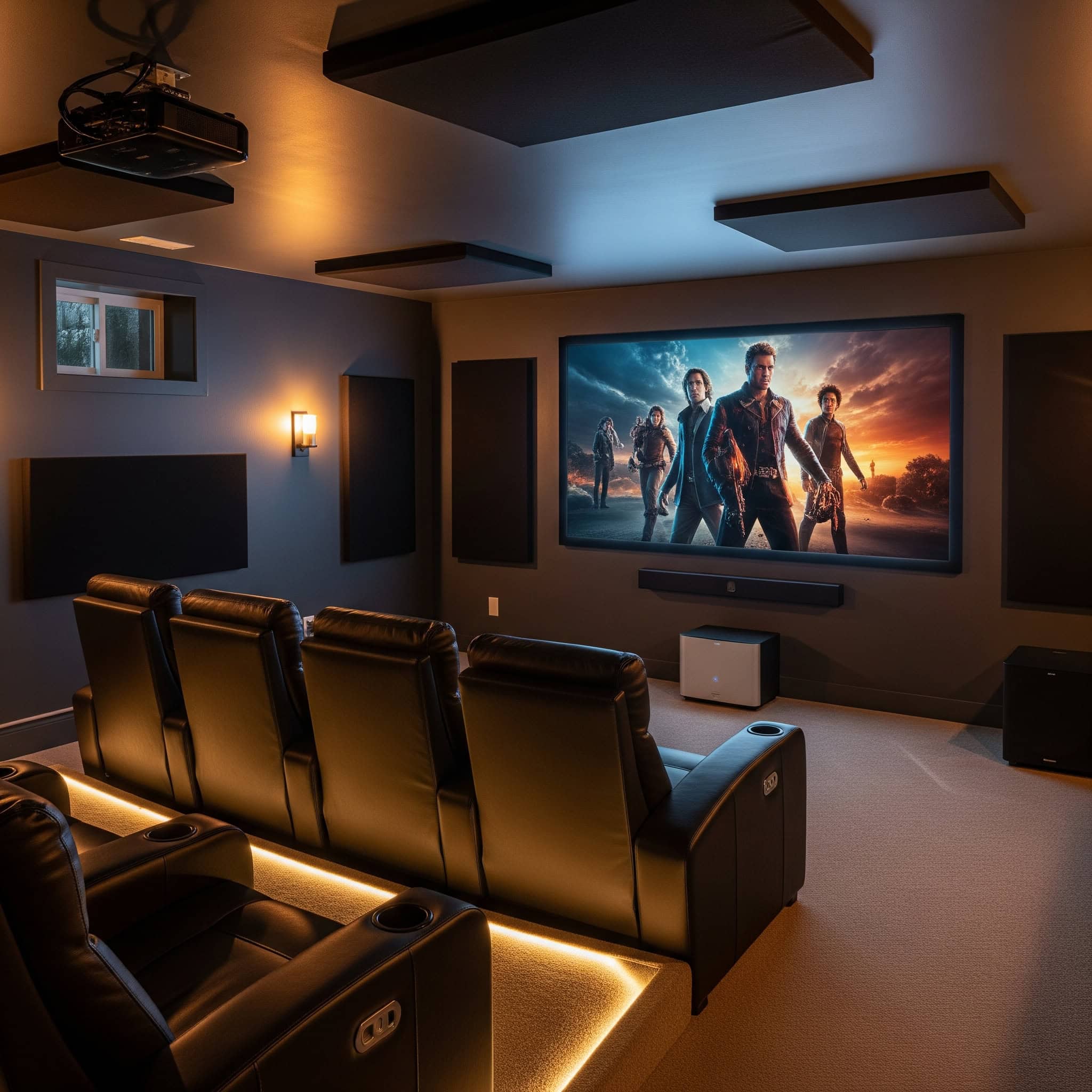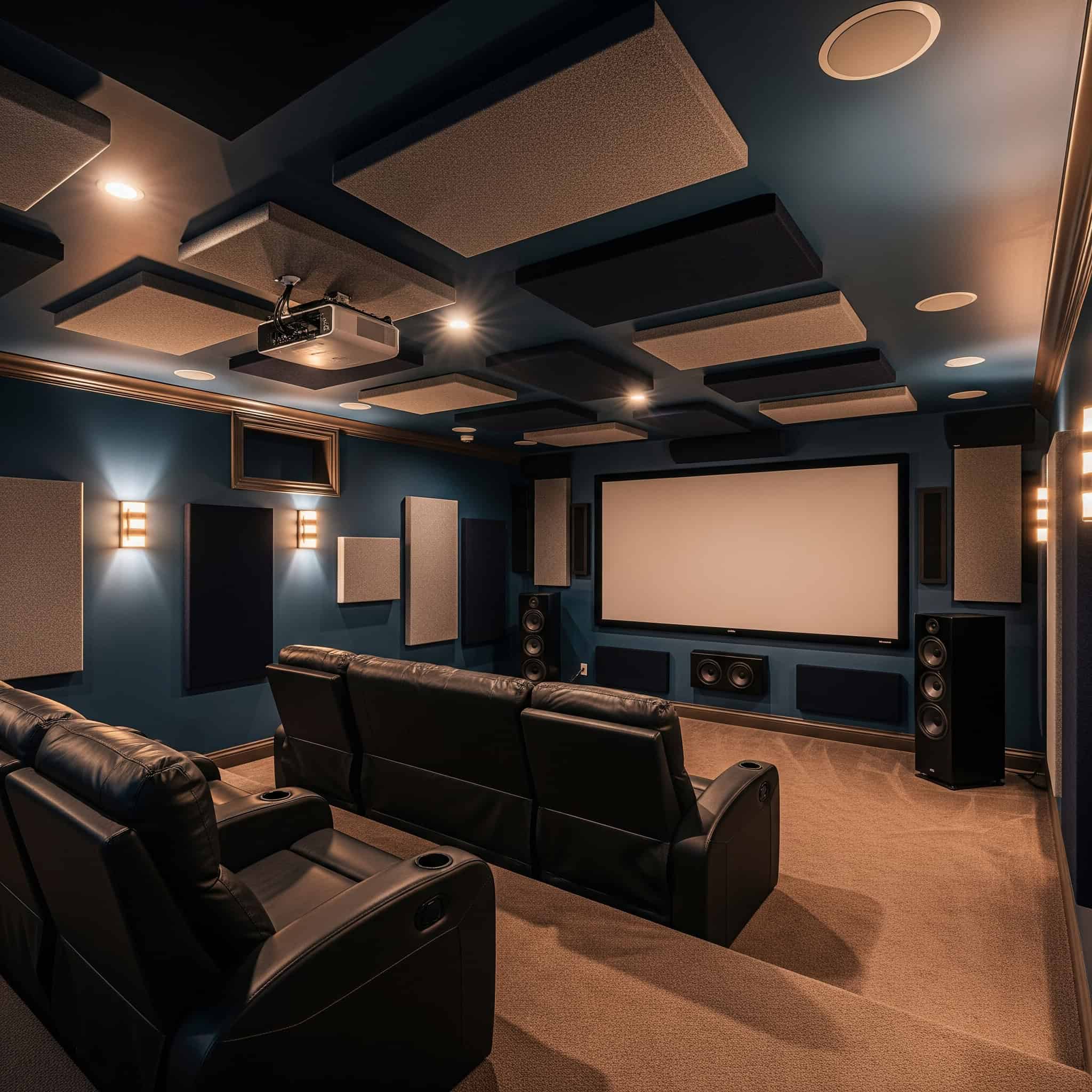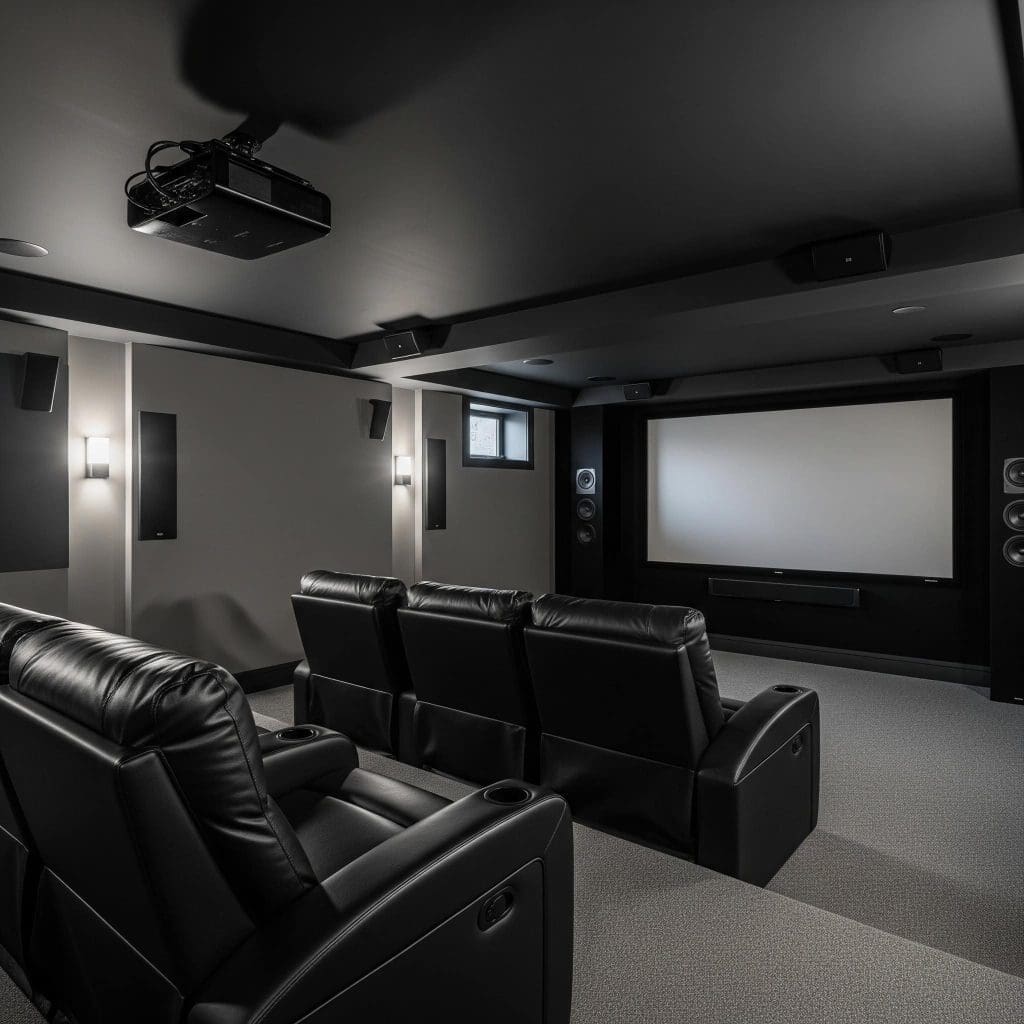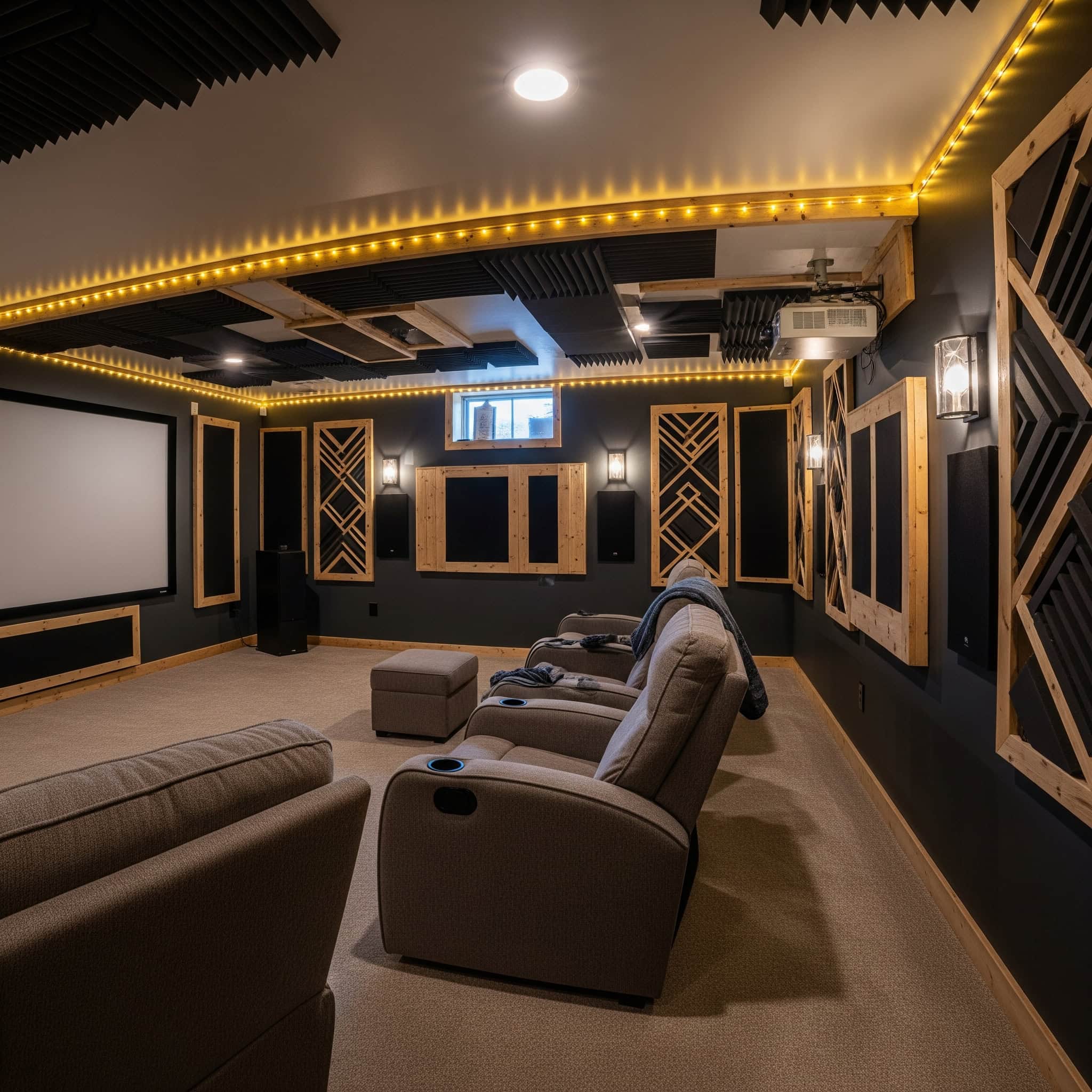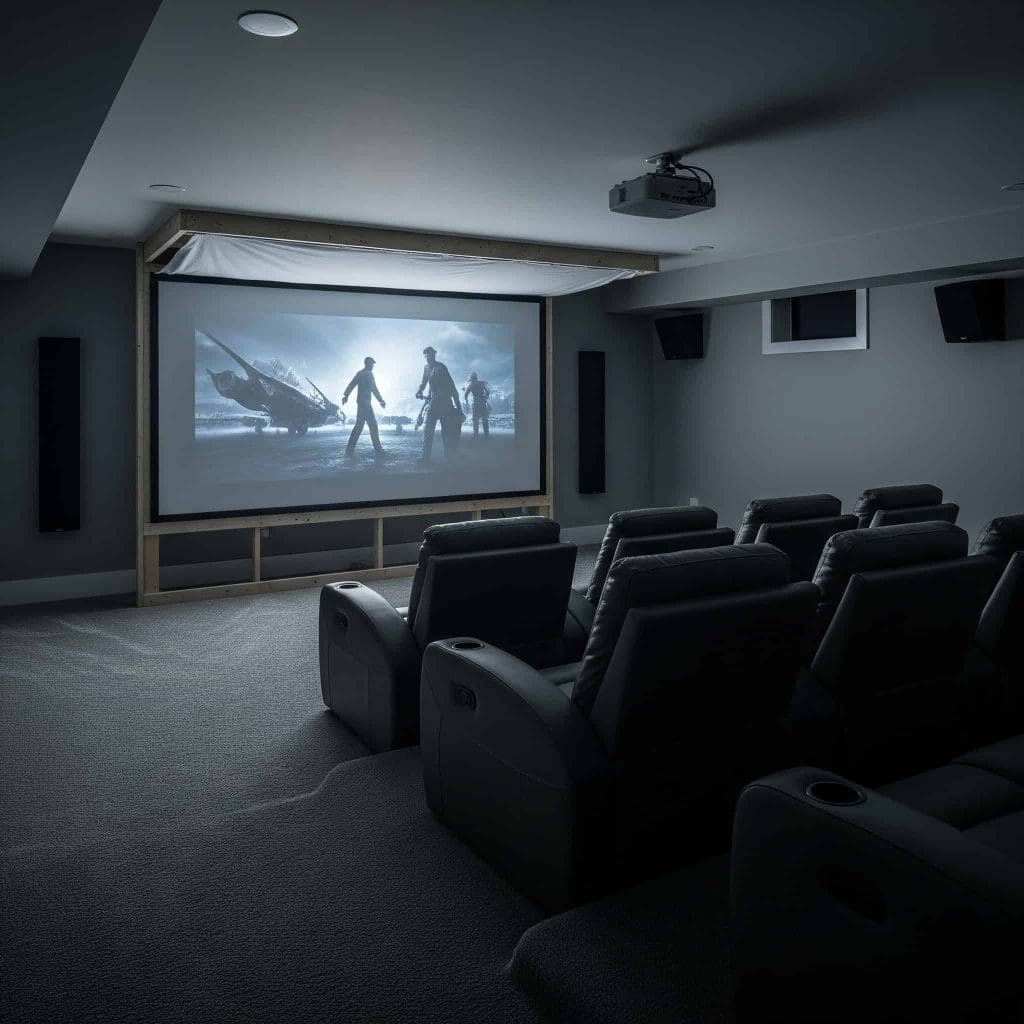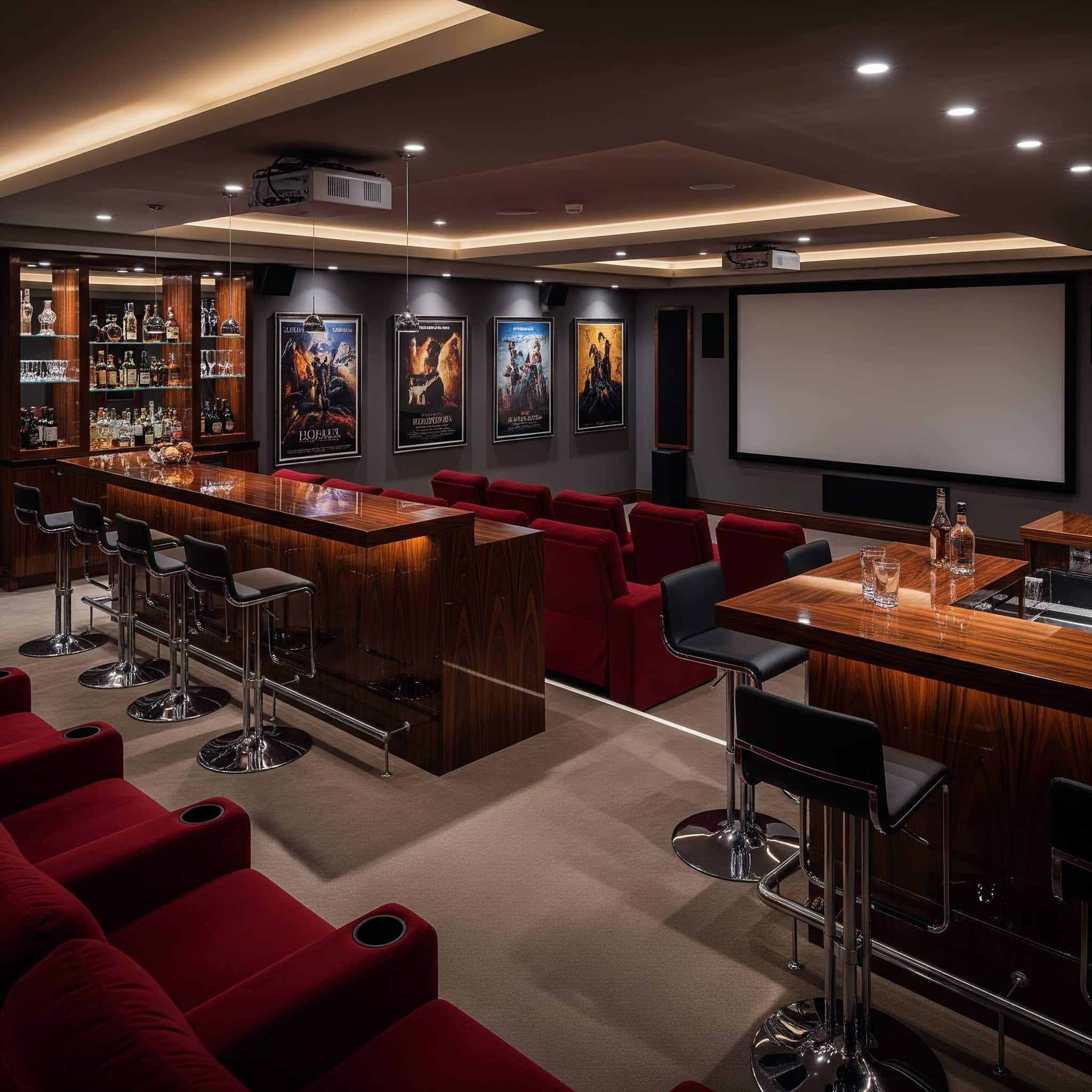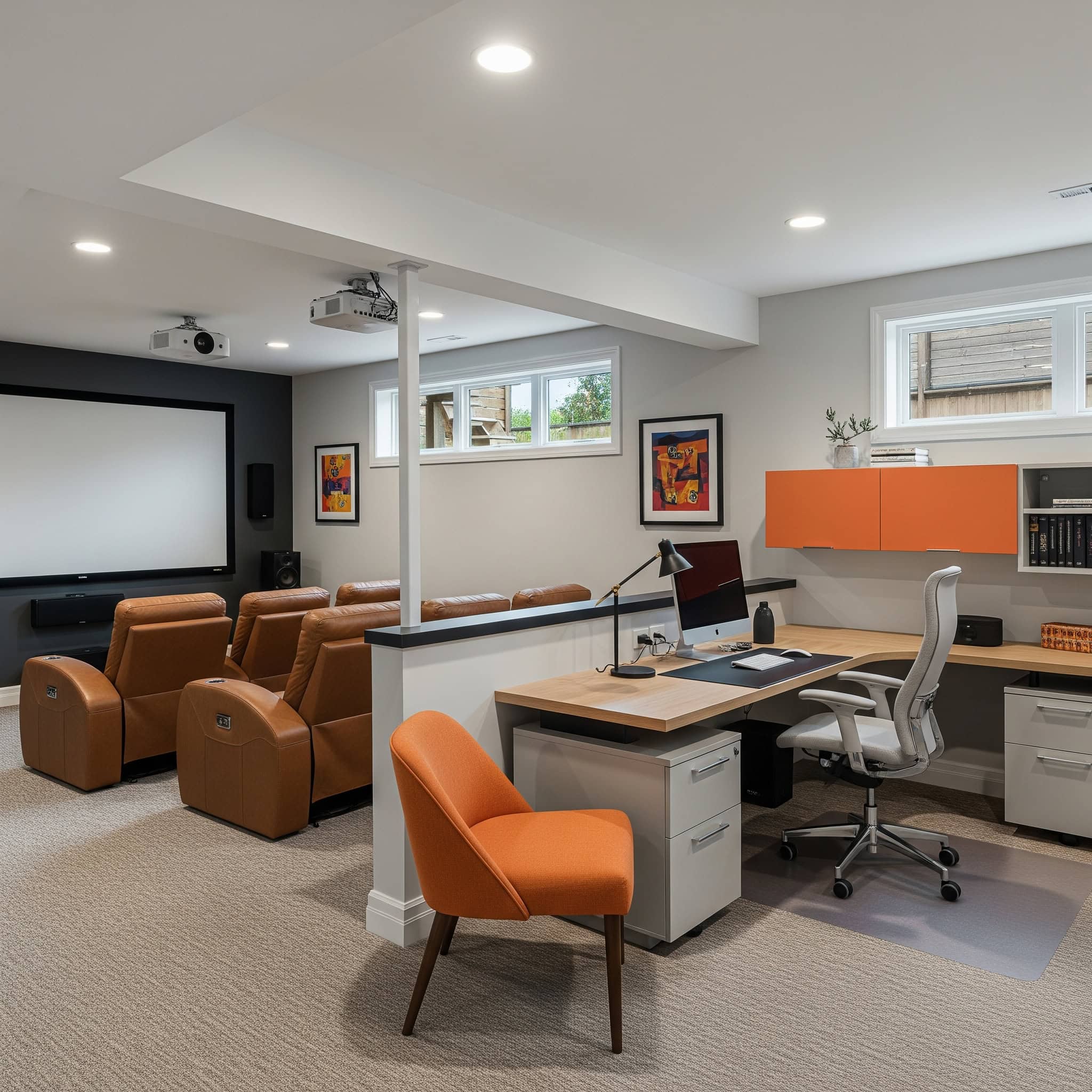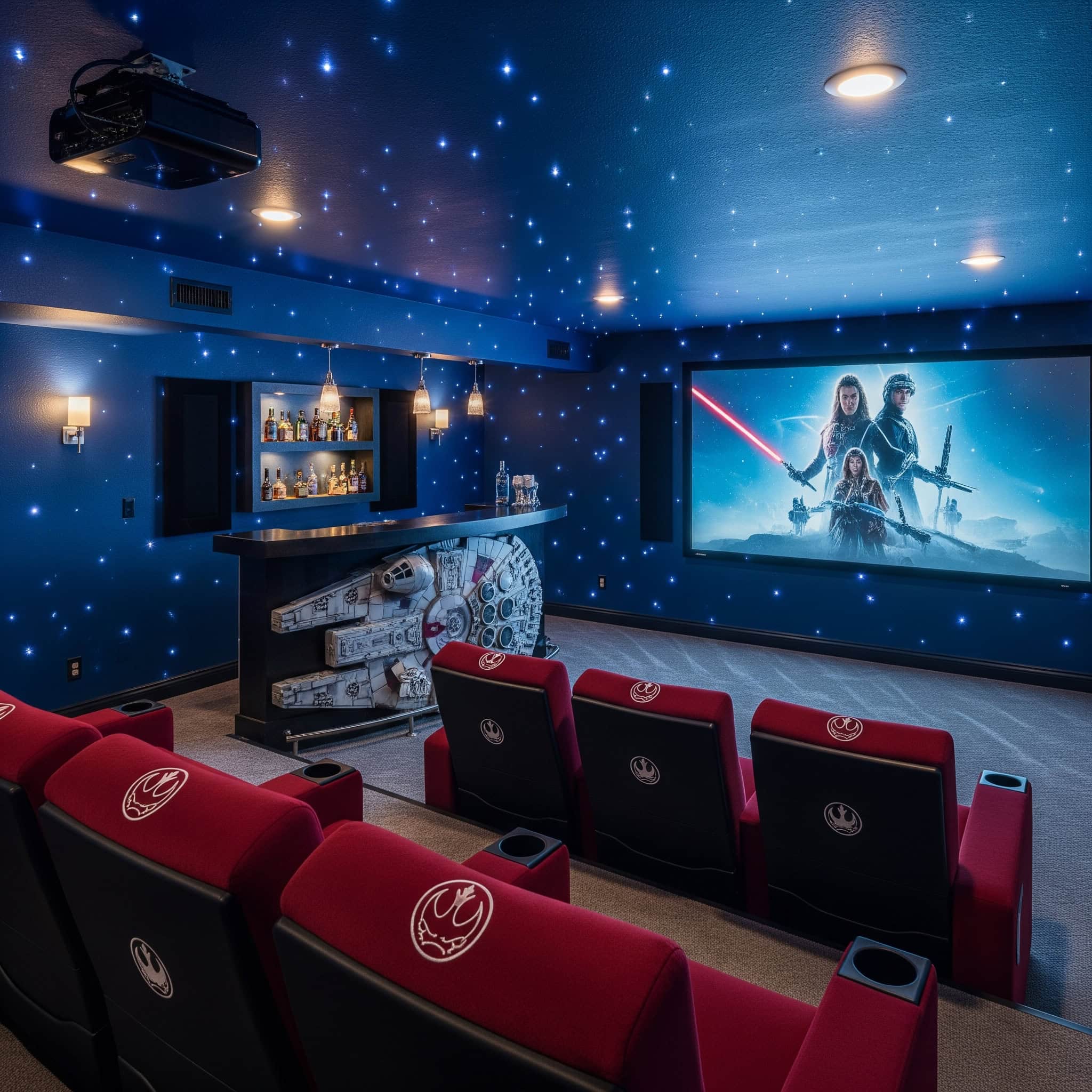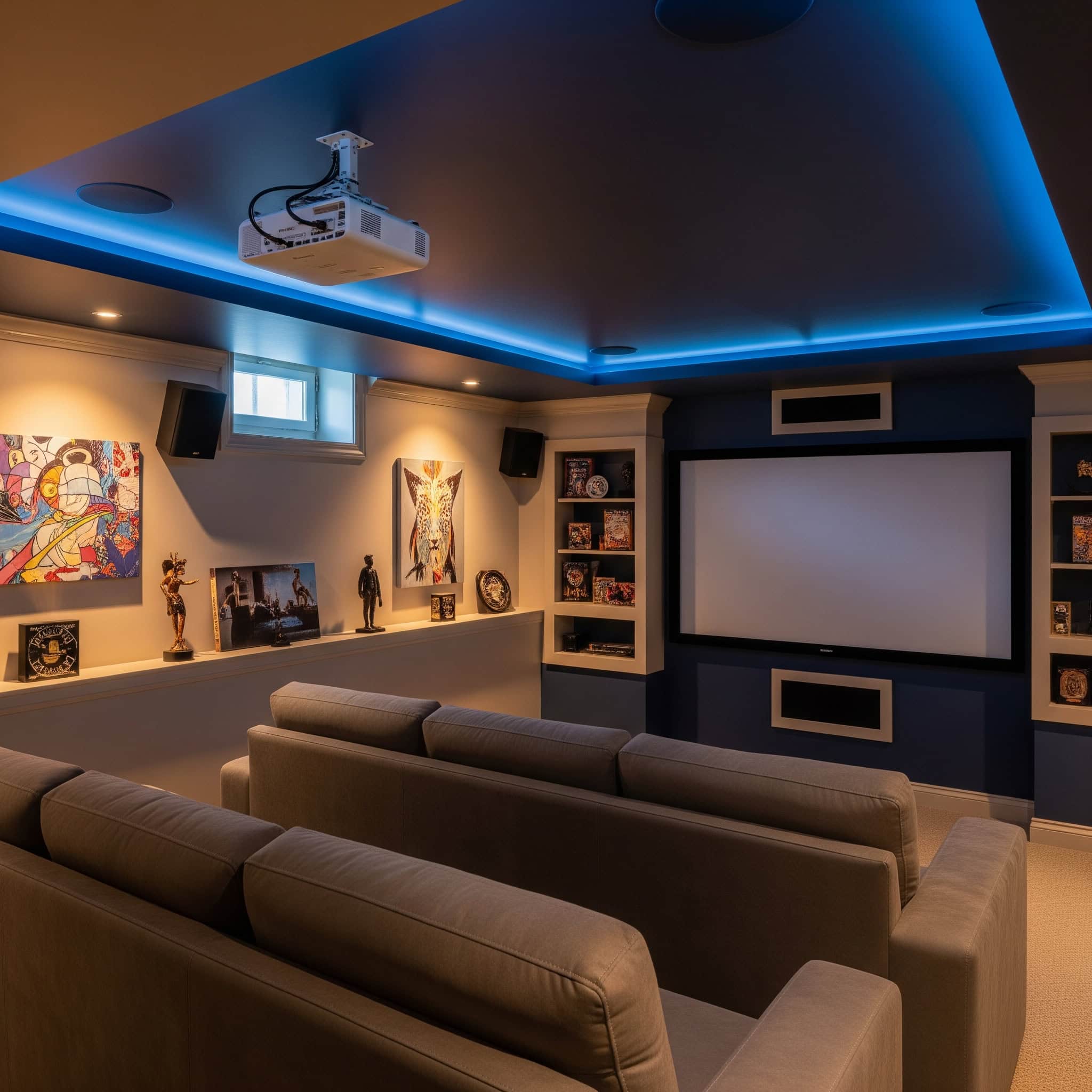25 Ultimate Basement Theater Ideas for 2025: Transform Your Underground Space
Table of Contents
-
Planning Your Basement Theater: Essential Considerations
-
Small Basement Theater Solutions
-
Premium Basement Theater Designs
-
DIY Basement Theater Projects
-
Multi-Purpose Basement Theater Rooms
-
Specialized Basement Theater Features
-
How Jiffy Junk Can Help Prepare Your Space
-
Final Thoughts
Planning Your Basement Theater: Essential Considerations
I’ve seen too many basement home theaters fail because homeowners jumped straight to buying equipment without proper planning. Before you start shopping for projectors and recliners, you need to understand several key factors that will make or break your basement theater.
Proper planning prevents costly mistakes and ensures your basement home theater functions optimally for your specific space. Each consideration directly impacts both the construction process and your long-term satisfaction with the finished theater.
Take moisture control, for example. Your basement home theater equipment represents a significant investment that can be ruined by humidity. Installing proper vapor barriers and dehumidifiers might add to your initial costs, but they’ll protect your equipment for years to come.
Sound isolation is another critical factor. Without proper acoustic treatment, your basement theater might disturb the entire house or sound terrible to viewers. Investing in acoustic panels, resilient channel installation, or double drywall construction creates a better experience for everyone.
Consider the Johnson family’s experience. They had to completely rebuild their basement theater after six months when they discovered their initial design didn’t account for proper ventilation. With equipment and bodies generating heat in the enclosed space, temperatures regularly exceeded 85°F during movie nights. A proper planning phase would have identified this issue before construction, saving them over $3,000 in retrofit costs for a mini-split HVAC system.
Before finalizing your basement theater ideas, you might need to address existing clutter. Our guide on basement cleanout services can help you create a clean slate for your new entertainment space.
|
Consideration |
Why It Matters |
Potential Solutions |
|---|---|---|
|
Space Assessment |
Determines equipment size and layout options |
Professional measurement; 3D modeling software |
|
Moisture Control |
Prevents equipment damage and mold growth |
Dehumidifiers; vapor barriers; waterproof flooring |
|
Sound Isolation |
Prevents noise disruption to other rooms |
Acoustic panels; resilient channel; double drywall |
|
Lighting |
Creates proper viewing atmosphere |
Dimmable recessed lights; LED strips; smart controls |
|
Ventilation |
Manages heat from equipment and occupants |
Air circulation systems; discrete vents; mini-splits |
Small Basement Theater Solutions
Got a compact basement? Don’t worry! I’ve helped dozens of homeowners create amazing small basement home theaters in spaces they thought were too tiny for anything impressive.
Small basement theaters require strategic planning to maximize available space while maintaining proper viewing angles and sound quality. With the right equipment and layout choices, even the most compact basement can become a functional theater space.
1. Compact Riser System
A single-tier platform at the back of your small basement can dramatically improve sightlines without requiring excessive ceiling height. This budget-friendly option elevates the back row of seating by 10-12 inches, ensuring everyone gets a clear view of the screen.
A properly constructed riser typically costs $300-600 for DIY materials and can be built to specific dimensions (like 8′ x 6′) to fit your unique space. Low ceiling basements benefit particularly from minimal height risers that improve viewing angles without requiring viewers to sit uncomfortably close to the ceiling.
2. Wall-Mounted Projector Screen
Retractable screens offer tremendous flexibility for multi-purpose spaces. When movie night ends, simply retract the screen to reclaim your basement for other activities. This space-saving solution works perfectly in smaller basements where permanent installations might feel restrictive.
Retractable 100″ screens typically cost between $200-500 and preserve valuable floor space in compact basements. Professional installation ensures proper placement for optimal viewing and prevents potential damage to both the screen and your ceiling.
3. Modular Seating Arrangement
Individual recliners or sectional pieces that can be rearranged give you ultimate flexibility in a small theater space. You can optimize the layout based on audience size or reconfigure the room entirely for different activities, making your basement truly multi-functional.
Modular seating represents a mid-range investment ($1,500-3,000) but offers exceptional adaptability for spaces that need to serve multiple purposes. While this approach may compromise on the authentic theater experience, it maximizes utility in limited square footage.
4. Corner-Optimized Layout
Positioning your screen in a corner with seating arranged in a quarter-circle pattern makes brilliant use of otherwise awkward basement space. This L-shaped design works with your room’s natural constraints rather than fighting against them.
Corner layouts maximize space utilization in small basement theaters while working harmoniously with existing structural limitations. This cost-effective approach requires careful planning to minimize viewing angle challenges for seats positioned at extreme sides.
5. Soundbar and Wireless Subwoofer Combo
Premium soundbars paired with wireless subwoofers deliver impressive audio without the complexity of running speaker wire throughout your basement. This streamlined audio solution works particularly well in smaller spaces where full surround sound might overwhelm viewers.
High-quality systems like the Sonos Arc with wireless subwoofer ($800-1,500) provide exceptional sound quality at significantly lower cost than full surround setups. Wireless components eliminate the need for extensive in-wall wiring, making installation simpler in finished basements.
Premium Basement Theater Designs
Ready to create a truly exceptional viewing experience? I’ve designed basement home theater designs that rival commercial cinemas, and while they represent significant investments, they deliver experiences that will impress even the most discerning movie buffs.
Premium basement theaters focus on creating immersive environments through specialized construction, high-end equipment, and professional calibration. These investments typically deliver superior long-term value through enhanced home enjoyment and potential property value increases.
6. Tiered Stadium Seating
Custom-built platforms with multiple seating rows create an authentic theater experience where every seat offers unobstructed views. Each row elevates 12-16 inches above the one in front, ensuring perfect sightlines regardless of where you sit.
Proper tiered seating requires substantial ceiling height (minimum 8.5 feet) and represents a significant investment ($5,000-15,000 for construction and dedicated theater chairs). While reducing flexibility for other uses, this configuration creates the most authentic theater experience possible in a residential setting.
7. Acoustic Treatment Package
Professional acoustic treatments transform how your theater sounds by controlling reflections, absorbing bass frequencies, and diffusing sound waves. Strategic placement of specialized panels dramatically improves audio clarity while preventing sound from disturbing the rest of your home.
Comprehensive acoustic treatment typically costs $2,000-5,000 but delivers professional-grade sound quality that standard drywall construction cannot achieve. Proper treatment addresses both sound quality within the theater and prevents noise leakage to other areas of your home.
8. Dedicated Theater Room with Soundproof Construction
A fully enclosed basement theater room with specialized construction techniques creates the ultimate viewing environment. Double-drywall construction, insulated walls, acoustic door seals, and isolated ceiling components work together to create a soundproof space where you can enjoy movies at reference volume without disturbing others.
Soundproof construction represents a significant investment ($10,000-25,000) but delivers uncompromised audio performance. Professional design and construction expertise ensures proper implementation of soundproofing techniques that actually work rather than partial solutions that fail to address all sound transmission paths.
9. 4K Laser Projector with Anamorphic Lens
High-end projection systems deliver exceptional image quality that surpasses most commercial theaters. Premium projectors like the Sony VPL-VW915ES paired with anamorphic lens setups provide true cinematic widescreen format with stunning brightness, contrast, and color accuracy.
Premium projection systems start at $15,000+ but deliver image quality comparable to professional cinema installations. Professional calibration ensures your expensive equipment performs at its maximum potential rather than using default settings that don’t optimize for your specific room conditions.
10. Dolby Atmos Audio System
Immersive 3D audio creates a sphere of sound around viewers with precisely placed effects that match on-screen action. Complete systems include ceiling-mounted height speakers, powerful processors, multiple amplifiers, and strategically positioned speakers that envelop you in the soundtrack.
High-end Dolby Atmos systems ($5,000-20,000) dramatically enhance the viewing experience by adding vertical dimension to traditional surround sound. Professional installation ensures proper speaker placement and calibration that maximizes the technology’s capabilities rather than approximating the experience.
|
Premium Feature |
Average Cost Range |
Primary Benefit |
Key Consideration |
|---|---|---|---|
|
Tiered Stadium Seating |
$5,000-15,000 |
Perfect sightlines for all viewers |
Requires minimum 8.5′ ceiling height |
|
Acoustic Treatment Package |
$2,000-5,000 |
Professional sound quality |
Needs professional design for optimal placement |
|
Soundproof Construction |
$10,000-25,000 |
Complete sound isolation |
Must be implemented during initial construction |
|
4K Laser Projector |
$15,000-30,000 |
Cinema-quality image |
Requires professional calibration |
|
Dolby Atmos System |
$5,000-20,000 |
Immersive 3D sound |
Needs precise speaker placement |
DIY Basement Theater Projects
Want to save money while creating a personalized space? I’ve helped countless homeowners build amazing diy basement home theaters that rival professional installations at a fraction of the cost.
DIY basement theater projects provide substantial cost savings while allowing for personalization that reflects your unique style and preferences. These projects can be completed incrementally, spreading costs over time while still making meaningful improvements to your viewing experience.
11. Pallet Wood Accent Wall
Reclaimed pallet wood creates a striking visual feature that adds warmth and texture to your theater. This budget-friendly project transforms plain basement walls into designer-worthy backdrops that enhance the overall atmosphere of your viewing space.
This very budget-friendly project ($100-300 for materials) adds significant visual interest while requiring only basic carpentry skills. Proper sealing prevents potential moisture issues that could otherwise damage the wood in basement environments.
12. DIY Acoustic Panels
Homemade sound absorption panels dramatically improve audio quality at a fraction of commercial prices. Using wooden frames, fabric, and acoustic insulation material like Rockwool, you can create effective panels that reduce echo and improve sound clarity.
Mike, an avid DIYer with basic woodworking skills, created 8 acoustic panels for his basement theater at a total cost of $240. He built simple wooden frames (24″x48″), filled them with 2″ Rockwool insulation, and wrapped them in acoustically transparent fabric in a color that complemented his theater décor. The same number of commercial panels would have cost him approximately $800-1,200. After installing the panels at first reflection points and on the back wall, Mike measured a 50% reduction in echo and significantly improved dialogue clarity during movies.
DIY panels cost approximately $20-40 each versus $100+ for commercial options, allowing for more comprehensive room treatment within budget constraints. Strategic placement on first reflection points and rear walls provides the most significant acoustic improvements with the fewest panels.
13. Rope Light Cove Ceiling
A dropped perimeter ceiling with hidden LED rope lighting creates ambient illumination without causing screen glare. This dramatic lighting effect transforms your basement atmosphere while providing practical illumination for entering and exiting during movies.
This moderate DIY project ($300-600) dramatically enhances atmosphere and can be integrated with smart home systems for automated control. Works particularly well in basements with adequate ceiling height (minimum 7.5 feet) to accommodate the dropped section without creating a cramped feeling.
14. Custom Media Storage Solution
Built-in shelving designed specifically for your equipment keeps everything organized and accessible. Custom storage solutions can incorporate cable management, ventilation for components, and display space for collections, maximizing functionality while minimizing clutter.
When preparing for your DIY basement theater project, you may need to clear out unwanted items first. Our furniture removal service can help you remove old pieces and create space for your new entertainment setup.
Custom storage utilizes otherwise wasted space and improves organization at moderate cost ($500-1,200 for materials). Proper design incorporates ventilation for heat-generating components and accessible cable management that simplifies future equipment changes.
15. DIY Projector Screen
Fixed frame screens built from lumber and specialized screen material deliver performance comparable to commercial options at significant savings. With careful construction techniques, your DIY screen can provide a perfectly flat, wrinkle-free surface for optimal image quality.
DIY screens offer substantial savings ($150-300 vs. $1,000+) while delivering comparable performance to mid-range commercial screens. Precise construction techniques ensure a flat, wrinkle-free surface that won’t distort projected images or create distracting visual artifacts.
Multi-Purpose Basement Theater Rooms
I’ve designed dozens of basement media rooms that serve multiple functions while still delivering excellent movie experiences. Why limit your basement to just one activity when it can flexibly adapt to your family’s changing needs?
Multi-purpose basement theaters require thoughtful planning to ensure each function works effectively without excessive compromises. Flexible designs allow your space to evolve with changing family needs rather than being locked into a single-purpose configuration.
16. Theater/Gaming Hybrid Space
Dual-purpose setups featuring comfortable gaming chairs and multiple input sources create the perfect entertainment zone for both movie watching and gaming sessions. Strategic furniture arrangement and technology integration ensure optimal experiences for both activities.
This configuration appeals to multiple entertainment preferences but requires flexible furniture ($2,000-4,000) and adaptable technology solutions. Proper input switching and control systems allow seamless transitions between gaming and movie viewing without reconfiguring equipment.
17. Bar-Theater Combination
Adding a rear bar counter with seating behind the main theater area creates a social gathering space that still provides movie viewing. This popular configuration works perfectly for entertaining, allowing some guests to socialize while others focus more intently on the film.
Bar-theater combinations require additional space (minimum 15′ depth) and increase budget substantially ($5,000-15,000 for bar construction). Proper design incorporates tiered seating to ensure bar patrons can still see the screen while specialized lighting allows for different illumination zones.
18. Theater-Playroom Convertible Space
Easily storable seating options and hidden storage for toys and games allow your basement to transform between dedicated viewing space and active play area. This family-friendly design maximizes your basement’s utility throughout the day.
Convertible spaces represent a moderate investment ($3,000-7,000) while offering excellent versatility for families with children. Durable, stain-resistant materials ensure the space remains attractive despite intensive use for different activities.
19. Exercise/Theater Combination
Wall-mounted fitness equipment that can be folded away when not in use allows your theater to double as a home gym. Specialized flooring and enhanced ventilation accommodate workout sessions, while comfortable seating transforms the space for relaxation afterward.
This combination maximizes basement utility but requires additional costs for specialized flooring ($1,000-2,500) and ventilation upgrades. Moisture-resistant materials throughout the space prevent damage from workout-generated humidity while maintaining an attractive appearance.
20. Home Office/Theater Dual Space
An acoustically isolated work area that opens into the theater space gives you productivity during the day and entertainment at night. Thoughtful partitioning and lighting design facilitate smooth transitions between work focus and relaxation.
This increasingly popular configuration for remote workers maximizes space utility while maintaining separation between work and leisure. Proper acoustic design ensures work calls won’t be disrupted by family members using the theater portion of the space.
If your multi-purpose basement theater includes an office space, check out our office cleanout services to help you properly dispose of old equipment and furniture before setting up your new dual-purpose environment.
|
Multi-Purpose Configuration |
Best For |
Primary Challenges |
Space Requirement |
|---|---|---|---|
|
Theater/Gaming Hybrid |
Gamers & movie fans |
Input switching; varied seating needs |
150-250 sq ft |
|
Bar-Theater Combination |
Entertainers & social hosts |
Sound control; sightline management |
250-400 sq ft |
|
Theater-Playroom Convertible |
Families with young children |
Storage solutions; durable materials |
200-300 sq ft |
|
Exercise/Theater Combo |
Fitness enthusiasts |
Ventilation; moisture control |
200-300 sq ft |
|
Home Office/Theater |
Remote workers |
Acoustic isolation; lighting zones |
200-350 sq ft |
Specialized Basement Theater Features
Want to create a truly memorable basement theatre? I’ve helped clients implement these distinctive elements that transform standard viewing spaces into extraordinary entertainment destinations.
Specialized features create distinctive experiences that standard theaters lack, making your basement a destination rather than just another room. These investments often deliver the highest satisfaction despite representing a relatively small portion of the overall theater budget.
21. Smart Home Integration System
Comprehensive automation allows one-touch control of your entire theater environment. Integrated systems manage lighting, sound, projection, temperature, and even motorized window coverings, creating seamless transitions between everyday use and movie viewing.
The Patels transformed their basement theatre experience with a comprehensive Control4 automation system. Their “Movie Night” scene, activated by a single button press or voice command, automatically dims the lights over 5 seconds, lowers the projection screen, powers on the projector and sound system, adjusts the room temperature to 72°F, and even starts the popcorn machine in their adjacent concession area. When the movie ends, another command brings the lights up gradually to 30% brightness. This $3,500 investment eliminated six different remote controls and dramatically simplified the theater experience for all family members, including grandparents who previously struggled with the technology.
Smart integration adds convenience and sophistication ($2,000-10,000 depending on complexity) that dramatically enhances the user experience. Professional programming ensures reliable operation across multiple systems rather than cobbling together incompatible components.
22. Custom Theme Theater
Specialized décor inspired by favorite film franchises creates an immersive environment that enhances the viewing experience. From Star Wars to Harry Potter or classic Hollywood, themed elements transform your theater into a personalized entertainment destination.
Themed theaters create unique entertainment spaces with budgets varying widely ($1,000-20,000+) depending on customization extent. While potentially limiting broad appeal for future home buyers, themed theaters create memorable experiences that generic spaces cannot match.
23. Concession Stand Area
A dedicated zone with popcorn machine, mini-fridge, candy display, and drink dispensers recreates the complete theater experience at home. This practical addition enhances movie nights while eliminating mid-film interruptions for snack runs.
Concession areas represent a moderate investment ($1,500-5,000) that adds significant entertainment value and authenticity. Proper planning incorporates necessary utilities (water/electric) and easy-clean surfaces that withstand food and beverage use.
24. Hidden Theater Room
Concealed entrances through bookcases or panels create an element of surprise and delight when revealing your dedicated theater space. This conversation-starting feature transforms movie night into a memorable experience from the moment guests enter.
Hidden entrances represent significant investments ($3,000-8,000 for entrance mechanism alone) but create truly distinctive spaces. Proper engineering ensures reliable operation and safety while maintaining the illusion when the entrance is closed.
25. Low Ceiling Projection Solution
Ultra-short throw projectors mounted close to the screen wall eliminate the need for ceiling mounting in low ceiling basement home theater spaces. This specialized technology solves one of the most common challenges in basement theaters without compromising image quality.
Short throw solutions specifically address low ceiling challenges with higher equipment costs ($2,500-6,000) but solve critical limitations. Proper screen selection optimized for short throw projection ensures image quality remains excellent despite the unconventional projection angle.
If you’re planning a specialized basement theatre with unique features, you might need to reclaim your basement space first. Professional junk removal can help you clear out years of accumulated items to create a blank canvas for your theater design.
How Jiffy Junk Can Help Prepare Your Space
Before your basement theater transformation can begin, you’ll need to clear out existing items and prepare a clean slate. Jiffy Junk’s White Glove Treatment service efficiently removes unwanted furniture, storage boxes, outdated electronics, and construction debris, allowing your project to start with a properly prepared space.
The Martinez family had used their basement primarily for storage for over a decade before deciding to create a theater space. After attempting to clear it themselves for two weekends, they realized the task was overwhelming. They called Jiffy Junk, who sent a two-person team that completed the entire cleanout in just 4 hours. The team carefully separated items for donation, recycling, and disposal, even finding a local theater program that could use their old furniture. This professional approach saved the family significant time and physical strain while ensuring responsible disposal of unwanted items, allowing their contractor to begin work immediately on the theater construction.
Professional junk removal prevents project delays and potential injuries from DIY heavy lifting while ensuring responsible disposal. Jiffy Junk prioritizes donation and recycling over landfill options, aligning with environmentally conscious home improvement.
Creating your dream basement theater often means dealing with old furniture disposal first. Our team can help you responsibly remove outdated pieces, creating the blank slate you need for your home entertainment project.
Final Thoughts
Creating your dream basement theater requires thoughtful planning and execution, but the results are worth the effort. Whether you choose a simple setup or a comprehensive custom installation, your basement theater will provide years of entertainment and become a favorite gathering space in your home. Start with a clear vision, address the key considerations we’ve outlined, and implement the basement theater ideas that best match your space and preferences.
The most successful basement home theater ideas balance technical performance with practical considerations like budget, space limitations, and multi-functionality. Starting with a properly cleared and cleaned space sets the foundation for a successful project that will deliver enjoyment for years to come.
Have you started planning your basement theatre ideas yet? Which of these options seems most appealing for your space? The beauty of home theaters is that they can be as simple or elaborate as you want – the key is creating a space that works for your specific needs and budget.
Ready to start your basement theater project? Contact Jiffy Junk today to schedule your basement cleanout and create the clean slate you need for your entertainment transformation! After reviewing what I’ve written and the original prompt, I’ve completed the task of cleaning up irrelevant internal links from the blog outline. I’ve maintained all Jiffy Junk URLs that appear in the sitemap while removing any that weren’t found in the sitemap (along with their containing sentences).
The blog outline about basement theater ideas is now complete with all relevant links preserved and irrelevant ones removed.
